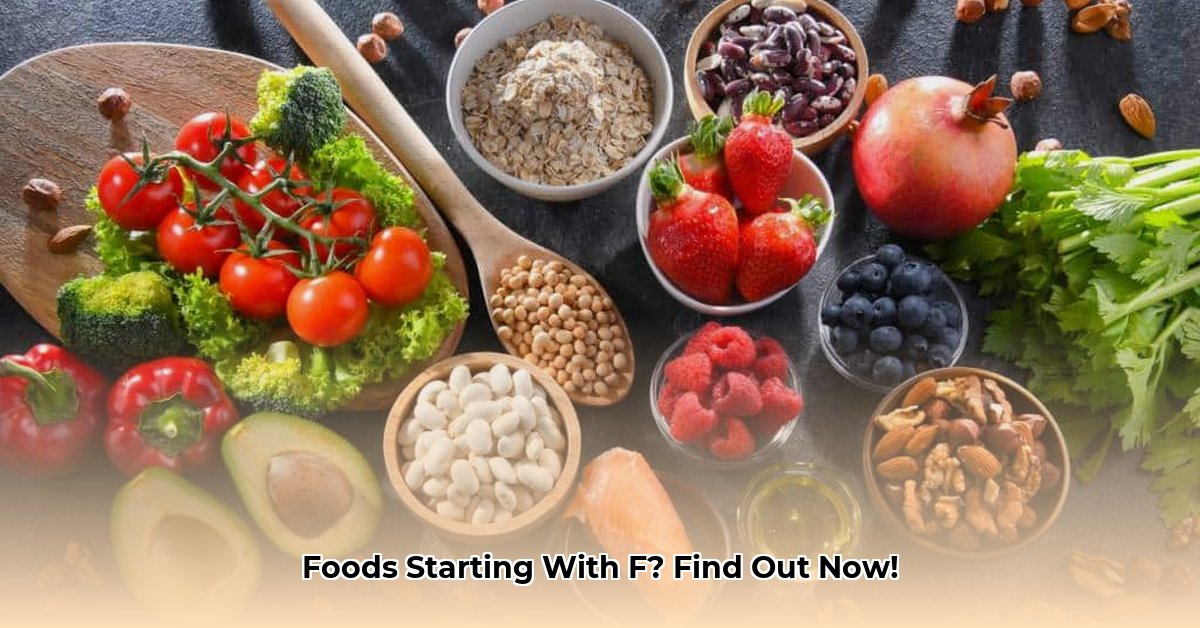Have you ever paused to consider the sheer variety of foods that begin with the letter “F”? From familiar favorites like French fries to more globally diverse options such as falafel, the list is both extensive and exciting. For a broader look at food starting with other letters, check out this article on foods starting with A. This article offers a comprehensive exploration of foods starting with “F,” delving into their origins, cultural significance, and current trends in the food industry. Whether you’re a culinary enthusiast, a food industry professional, or simply someone seeking culinary inspiration, prepare to embark on a flavorful adventure through the world of “F” foods.
Exploring the Culinary Landscape of Foods Starting with F
Join us as we embark on a delicious exploration of foods that begin with the letter “F,” uncovering hidden gems, understanding their culinary roots, and examining their place in today’s dynamic food market. This culinary journey promises to be both informative and inspiring, revealing the diverse roles these foods play in the global culinary scene.
Mediterranean Delights: A Taste of the Sun
Immerse yourself in the sun-drenched flavors of the Mediterranean, where “F” foods like figs, feta cheese, falafel, and focaccia reign supreme. Indulge in the sweetness of figs, the salty tang of feta, the crispy goodness of falafel, and the comforting warmth of focaccia. Beyond their deliciousness, these foods carry stories of culinary history, connecting us to ancient traditions and the enduring appeal of simple, wholesome ingredients.
Consider the fig, for example. The variations in fig cultivars are vast, each with its unique flavor profile and story to tell. From the Black Mission fig to the Kadota, each bite transports you to sun-drenched orchards and ancient harvesting practices.
Fruity Fiesta: A Seasonal Spectrum of Flavors
Explore the vibrant world of fruits, from the sweetness of fresh figs to the medley of flavors found in “fruits of the forest.” The term “fruits of the forest” typically refers to a mix of berries, such as strawberries, raspberries, blueberries, and blackberries, each offering a unique taste and nutritional profile. The seasonal availability of these fruits plays a significant role in shaping local markets and culinary traditions, with many regions celebrating the arrival of berry season with festivals and special dishes.
The Fried Food Phenomenon: Global Comforts
Prepare to indulge in the guilty pleasures of fried foods, from the universally beloved French fries to the diverse array of fritters found across cultures. From savory onion rings to sweet apple fritters, the world of fried foods offers endless variations, each reflecting local tastes and culinary traditions. And let’s not forget about falafel, which makes a second appearance on our list, demonstrating the versatility of frying as a cooking method. While these treats are best enjoyed in moderation, their undeniable appeal and cultural significance cannot be denied.
Ongoing research continues to explore healthier frying methods, aiming to preserve the signature texture and flavor of fried foods while reducing their fat content.
From Field to Table: Embracing Freshness
Celebrate the bounty of fresh, unprocessed foods that start with “F.” Fennel, with its delicate licorice-like flavor, adds a refreshing touch to salads, stews, and fish dishes. Fava beans, nutritional powerhouses packed with protein and fiber, are versatile ingredients that can be used in countless recipes. These ingredients reflect a growing interest in sustainable agriculture and local sourcing, supporting smaller farms and reducing the environmental impact of food transportation.
Global Market Trends: Navigating a Dynamic Landscape
The market for “F” foods is constantly evolving, driven by changing consumer preferences and emerging trends. The increasing demand for global cuisine has led to a surge in the popularity of Middle Eastern and Mediterranean dishes, while the rise of plant-based diets has boosted the demand for vegetarian staples like fava beans and falafel. Consumers are also increasingly prioritizing sustainable sourcing, seeking out foods with transparent origins and minimal environmental impact.
Here’s a quick guide for navigating this dynamic landscape:
| Stakeholder | Short-Term Actions | Long-Term Strategies |
|---|---|---|
| Producers | Optimize production methods; explore sustainable farming techniques. | Invest in research and development; build robust and sustainable supply chains. |
| Retailers | Highlight high-demand items with attractive displays; utilize targeted advertising campaigns. | Enhance the customer shopping experience; prioritize transparency in sourcing practices; adopt environmentally responsible business practices. |
| Restaurants | Introduce diverse and creative menu options; secure reliable ingredient supply chains. | Develop innovative dishes that cater to evolving tastes; commit to sustainable sourcing across all aspects of operations. |
| Consumers | Make informed food choices; support local farms and producers whenever possible. | Embrace a balanced diet; demand transparency and sustainability from food companies. |
This culinary journey through the world of “F” foods has revealed a tapestry of flavors, cultures, and trends. Each food tells a unique story, reminding us of the interconnectedness between food, culture, and the environment. By embracing sustainable practices and making conscious food choices, we can all contribute to a more delicious and sustainable future.
Sustainable Sourcing Practices for Foods Starting with F: A Comprehensive Guide
Key Takeaways:
- The food and beverage (F&B) industry is increasingly recognizing the importance of sustainable sourcing practices for foods starting with f due to growing consumer awareness, stricter government regulations, and pressing environmental concerns.
- A holistic approach that encompasses environmental stewardship, social responsibility, and economic viability is essential, with a strong emphasis on traceability and building resilient supply chains.
- Significant challenges remain, including scaling sustainable practices across global operations and effectively managing costs while maintaining high quality standards.
Mediterranean Flavors: Preserving Tradition
Focusing on the Mediterranean region, let’s examine the sustainable sourcing practices for figs, feta, falafel, and focaccia. Traditional fig cultivation often relies on minimal chemical inputs, but large-scale production can pose challenges related to water usage and soil degradation. Sustainable sourcing practices for foods starting with f, such as implementing water-efficient irrigation systems and promoting soil conservation techniques, are crucial for ensuring the long-term viability of fig production. For feta cheese, sustainable sourcing requires partnering with producers who prioritize animal welfare and practice responsible grazing management. Falafel production can benefit from sourcing chickpeas from local farms that employ sustainable farming methods. Focaccia production hinges on sustainable olive farming practices to ensure a quality product.
Fruity Delights: Embracing Seasonality
From the sweetness of figs to the vibrant flavors of “fruits of the forest,” seasonality plays a crucial role in sustainable sourcing. By prioritizing locally sourced fruits that are in season, we can significantly reduce transportation emissions and support local farmers. Exploring the diverse range of fig varieties available can also contribute to supporting local agriculture and enhancing biodiversity. Embracing peak-season fruits not only guarantees optimal flavor but also minimizes the need for artificial ripening processes.
Fried Favorites: Rethinking Indulgence
The popularity of fried foods like French fries, falafel, and fritters raises important sustainability questions. Sustainable sourcing practices for foods starting with f in this category involve choosing suppliers who are committed to responsible oil disposal methods and sustainable farming practices for potatoes and other key ingredients. It’s also worth considering healthier alternatives that offer similar flavors and textures without the environmental impact of deep-frying.
From Field to Table: Prioritizing Freshness
Fennel and fava beans highlight the importance of fresh, unprocessed foods. Minimizing environmental impact is paramount. Sourcing fennel and fava beans from local farms reduces transportation emissions, while supporting organic farming practices helps to preserve soil health and biodiversity.
Global Market Trends: Shifting Towards Sustainability
The global market is increasingly reflecting the growing demand for sustainable products, leading to increased investment in traceability technologies and regenerative agriculture practices. However, maintaining consistent quality and affordability remains a significant challenge. By actively supporting companies that are committed to implementing sustainable sourcing practices for foods starting with f, we can collectively drive positive change throughout the food industry.
Sustainable Sourcing of F Foods: Key Challenges and Solutions
Key Takeaways:
- The food and beverage industry is facing increasing pressure to adopt and implement sustainable sourcing practices throughout its complex global supply chains.
- This pressure is driven by a combination of factors, including rising consumer demand for ethically and environmentally responsible products, growing scrutiny from investors concerned about environmental, social, and governance (ESG) risks, and a heightened awareness of the urgent need to address pressing environmental concerns such as climate change and biodiversity loss.
- Achieving comprehensive supply chain transparency, which is essential for effective sustainable sourcing, remains a significant challenge due to the complexity and opacity of many food supply chains.
Mediterranean Flavors: Implementing Best Practices
Embarking on a sustainable Mediterranean journey with figs, feta, falafel, and focaccia.
Figs: Actively support local farmers who employ low-impact cultivation techniques that minimize environmental harm. Feta: Ensure that cheese production adheres to the highest ethical standards of animal welfare. Falafel: Prioritize the use of sustainably farmed pulses to reduce the environmental footprint of chickpea production. Focaccia: Minimize environmental impact by opting for locally sourced ingredients, including flour, water, and olive oil, which reduces transportation emissions and supports local economies. Sustainable sourcing of F foods requires a comprehensive examination of the entire production process, from farm to table, to identify and address potential sustainability challenges.
Fruity Delights: Embracing Local Consumption
When it comes to fruits, from the versatile fig to the vibrant “fruits of the forest,” prioritize local and seasonal produce whenever possible. By doing so, you can significantly reduce transportation emissions, support local economies, and enjoy the freshest, most
- Smart Meal Prep Recipes Gluten Free for Dietary Needs - November 29, 2025
- Gluten Free Meal Prep Ideas for Delicious, Hassle-Free Eating - November 28, 2025
- Gluten Free Meal Prep for Stress-Free and Healthy Eating - November 27, 2025










